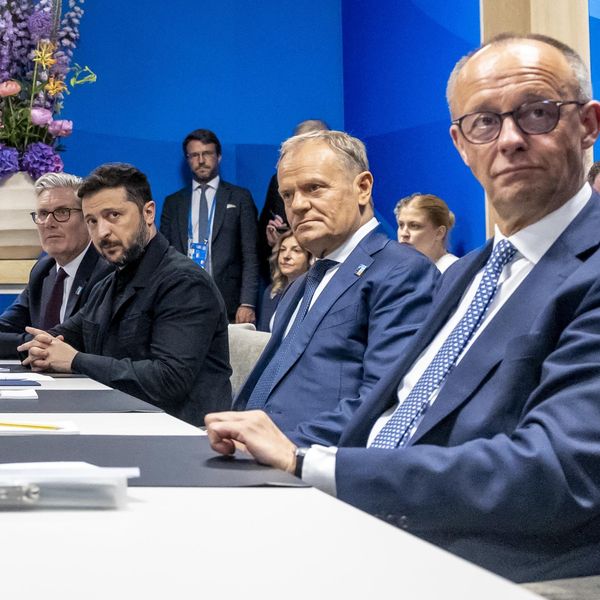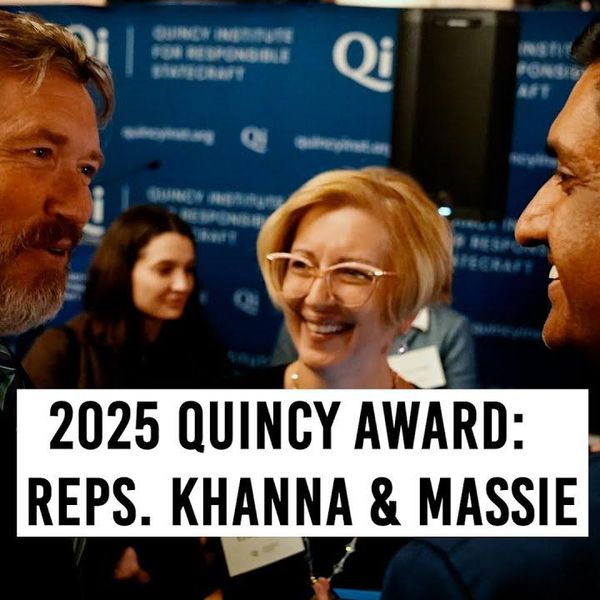To understand the actual forces shaping US foreign policy, it is imperative to put aside the alluring but misleading notion that a “doctrine” provides a useful guide to explaining or predicting the decisions of any president or administration. Take the “Obama Doctrine.” Constructed around the musings of a president struggling to rationalize his reactions to the 2011 Arab Spring, this imaginative concept provided an ex post facto story of decisions that were largely improvised—and often on the fly.
The logic of improvisation endures. The Biden Administration’s approach to Iran, Gulf security, the question of democracy, or the Palestinian-Israeli “peace process” cannot be attributed to some kind of doctrine—or even its close cousin, a strategy. Buffeted by sudden events, by a myriad of increasingly entangled regional and global players, and by endless bureaucratic politics and domestic policy struggles, Biden’s advisors have followed the long-practiced tradition of just muddling through. This point was underscored by the president’s January 19 press conference, which included a frank (if perhaps politically inconvenient) account of the White House’s efforts to manage the Ukraine crisis—a situation that rang alarm bells in many foreign capitals but was surely welcomed in Moscow.
Buffeted by sudden events, by a myriad of increasingly entangled regional and global players, and by endless bureaucratic politics and domestic policy struggles, Biden’s advisors have followed the long-practiced tradition of just muddling through.
Wrestling with this messy picture, some Arab pundits have argued that the administration’s policies are fueled by an understanding of new and emerging geostrategic tests, the most potent of which is China. The idea that a still powerful, albeit declining, superpower is grappling (and sometimes stumbling) day by day with such challenges is hard to fathom. But to grasp more fully what might be called Biden’s “non-doctrine,” more reasonable and perhaps lower expectations regarding the presumed motives, plans, and goals animating US Middle East policy are surely in order.
Arab analysts nailing Jell-O to the wall
As they ponder the first year of the Biden presidency, Arab analysts have offered a range of interpretations, two of which stand out. Echoing the status quo concerns of Saudi Arabia, the United Arab Emirates, Israel, and Egypt, the first group holds that the Biden Administration’s policies reflect a deliberate strategic pivot toward Asia, and China in particular. This change, it is said, has rewarded regional troublemakers such as Syria and Iran (and its proxies) while punishing Washington’s Middle East friends. Echoing an anti-status quo perspective, a second group acknowledges the emergence of a new kind of cold war mentality focused on China. But this group sees it as a dangerous or cynical misrepresentation of the global arena’s shifting geostrategic fault lines, one that is distracting attention from what, in reality, is a neo-isolationist foreign policy driven first by US domestic economic and political struggles and challenges. This view suggests that the Middle East might be best served by less, rather than more, American attention.
The Chinese are coming!
The pro status quo perspective has been set out in a series of articles published in the Cairo-based Al-Ahram media center. Tarek Osman argues that the US withdrawal from Afghanistan heralded the key animating theme of Biden’s foreign policy, namely that “wars for no clear reason and that have no clear ends are in the past.” Designed for a “new global order,” this policy has led to the shrinking of US military forces in Europe, and even to their “disappearance” in the Middle East. The disengagement “from most dossiers that do not have international implications” is manifest in a decade-long process by which the United States has shifted its “strategic positioning” to East Asia, the “theatre that will witness the first phase of its strategic confrontation with China.”
This change, Osman adds, “is vastly different from anything [the United States] witnessed throughout the Cold War.” It is different because the “decay inside the US” as it exists today means that the United States cannot muster the resources it mobilized to defeat the Soviet Union. Nevertheless, Osman holds that the Biden Administration does not want to pursue a policy of “engagement” with China to simply manage the status quo; rather, it seeks a “winning” strategy to curb “some of the successes that China has already secured” in part of the Pacific. The policy, he writes, has the United States “leaning forward—partly anxious, partly relishing the challenge, and certainly taking an assertive posture.” The “level of intensity of this strategic confrontation” generated by this policy will largely be determined by “China’s calculus and way of operation.”
Elaborating on this theme one week later, on November 30, 2021, Osman highlighted the tension between China’s global economic interests and a “transactional approach it has been using over the past decade” with its expanding and ideologically driven “grand idea of its rise.” Which of these two impulses prevails, he concludes, might depend on how other countries—not least of which are Japan and India—position themselves between the United States and its increasingly ambitious Chinese rival.
Osman penned this second article some two weeks after the online summit between Biden and Chinese President Xi Jinping. Writing for Al-Ahram, Hussein Haridy takes a less gloomy approach. Noting that during his September 2021 speech before the United Nations General Assembly, Biden asserted that the United States does not seek another Cold War with China, Haridy argued that this pragmatic “spirit” seemed to prevail during the November summit. Nevertheless, he noted that in a report issued prior to the meeting, the Pentagon held that China was continuing its “overall development, including its economic growth, strengthening its armed forces and taking a more assertive role in global affairs.” The Pentagon report elicited a response from American political leaders such as Representative Mike Rogers (R-Alabama), ranking member of the House Armed Services Committee. Rogers stated that “China poses a real and imminent threat.” Whether exaggerated or not, Haridy maintains that this statement shows that “international peace and security over the next half century” will depend on the course of US-China relations.
The second group of Arab analysts acknowledges the emergence of a new kind of cold war mentality focused on China that is a dangerous or cynical misrepresentation of the global arena’s shifting geostrategic fault lines.
The above two reasonable views of China contrast with Hazem Saghieh’s more alarmist yet plausible argument in Asharq al-Awsat. He fears that the contest between ideology and state interests (especially in the economic field), coupled with the totalitarian impulse of China’s president and his domestic political allies, will stamp out any vestige of freedom at home while placing China on the road to a major confrontation with the West.
Neo-isolationist realism is coming (and never left)
Reflecting on Biden’s first year, the Egyptian writer Abdel Halim Kandil contends that Biden’s “historical consciousness” was formed in the “post-WWII world, which ended with Washington winning its battle with the exhaustion and fall of the former Soviet Union.” This experience, he implies, is a burden for the new president because in point of fact, the US victory achieved during the Cold War “does not seem possible to repeat with China and Russia, the two integrated allies”—which, with China in the lead, are creating new global realities. Thus, he warns, the Biden Administration should not resort “to the same outdated tricks, such as pretending to lead what it calls the ‘free world’.” Nor should it try to repair “the widening cracks” in NATO or the European Union “by holding ‘caricature’ summits under the titles of democracy and human rights.” Faced at home by a polarized polity, the endless drama of COVID-19, and rising economic problems, the president, Kandil seems to suggest, has conjured up a new global mission that the United States is incapable of pursuing abroad.
Marwan Bishara offers a similar argument. Despite Biden’s “passion and determination about democracy and human rights,” he has gone on to “appease dictators like Egypt’s Abdul Fattah el-Sisi.” But the contradictions in US foreign policy are not limited to the Middle East. Despite all the talk of multilateralism and consultation, the administration’s actions in Afghanistan and elsewhere suggest an “indifference towards Europe” that is now reflected in an expanding gap “between the US and its Western allies over how to deal with Russia.”
And yet, even as Biden falls on a “Cold War mindset” by “framing today’s superpower competition as one between democracy and autocracy,” Bishara asserts that “unlike the Soviet Union, China and Russia are part and parcel of today’s Western-erected world system.” Indeed, he concludes, what the Biden Administration wants is not so different from its adversaries: to pursue its self-interest. Thus, Biden is not so different from his predecessor. His “commitment to make America more credible and respected around the world has failed as miserably as Trump’s commitment to ‘make America great again’.”
What is to be done?
These contrasting takes on US global policy and their link to Middle East realities point to very different policy conclusions. The pro status quo group argues that the presumed US focus on (if not obsession with) China has led the Biden Administration not only to neglect its friends in the region but to do severe damage to its own interests. Thus, Dania Koleilat Khatib argues that the US retreat “from world affairs, especially from the Gulf region,” has produced a policy of “frozen conflict” that has opened the door to an escalating clash of multiple parties seeking to fill the void, thus producing “a policy of chaos.” The latest example of this dynamic, she notes, was the attack on January 20 by Islamic State forces on a Kurdish-maintained prison in Hasaka, Syria. When such events occur, she suggests, one would normally expect that policies would “be disrupted and adjusted.” While not sure that the Hasaka attack will shake the administration’s preference for status quo policies in the Middle East, she nevertheless concludes that “at some point, the US will have to take action.”
The January 18 drone attack on the United Arab Emirates by the Iran-backed Houthi militia provided a seemingly opportune occasion to make this case for US action. Noting that in the wake of the attack, the Biden Administration is considering “restoring the Iran-backed Houthi militia in Yemen to the US list of foreign terrorist organizations,” Faisal J. Abbas asserts that Biden is a “deeply reflective” leader, “sometimes, perhaps, too much so.” The world, he writes, is not as complicated as the president and his advisors imagine. Indeed, while it is “axiomatic that the foreign policies of any country … are ultimately driven by self-interest,” the Biden administration “is almost literally shooting itself in the foot.”
As Abbas’s analysis indicates, these prescriptions focus on the perceived failure of the United States to work with its Middle East friends to stand up to Iran. Dania Khatib contends that with the “epicenter” of global politics “moving to Eurasia, with a likely Russian-Chinese alliance,” and the United States “slowly losing its place on the world stage,” Tehran and Moscow feel the winds behind their sails. Thus in the Vienna nuclear negotiations, the Iranians are “refusing to talk directly to Washington. How humiliating is that?” To remedy this situation, the Biden Administration “should start by showing a firm commitment to its allies and decisiveness when facing its foes.” Similarly, Baria Alamuddin asks if Washington is “ready to do what it takes to address … the likelihood of Tehran achieving nuclear breakout capacity?” With reports suggesting “wholesale policy confusion in the event of negotiations failing,” she doubts that the White House will exit this foreign policy fog by signaling a credible readiness to use military force.
The key weakness of Arab analyses is that while they highlight the dramatic shifts unfolding in the international arena, they imply that the United States still retains the military and economic resources to shape global politics.
The key weakness of the above analyses is that while they highlight the dramatic shifts unfolding in the international arena, they imply that the United States still retains the military and economic resources to shape global politics. By contrast, those analysts who see the US pivot to an Asian “cold war” mentality as little more than neo-isolationism dressed up as multilateralism do not believe that Biden has the means—or even the interest—in bringing “America back.” For better or worse, the full throttled inditement of the Biden Administration offered by the anti-status quo analysts provides no obvious or simple way forward for US foreign policy.
Inconvenient realities
The above analyses share the premise that the Biden White House is guided by an overarching idea, namely that shifts in the global order require a realignment of US foreign policy. Some mourn this shift and hope that the United States will wake up, while others are not sure that the country can or should do anything.
To be fair, the administration has fed this realignment thesis. From the president on down, its official policy pronouncements articulate what Secretary of State Antony Blinken calls a “foreign policy for the American people” that links domestic challenges to a revitalized—if US-led—engagement strategy. This strategy, he claims, responds to the fact that “several countries present us [the United States] with serious challenges, including Russia, Iran, North Korea” while focusing on “the challenge posed by China,” which “is different.” China, he adds for good measure, is “the only country with the … power to seriously challenge … all the rules, values, and relationships that make the world work the way we want it to, because it ultimately serves the interests and reflects the values of the American people.” The struggle with China is thus a struggle for the American way.
This Rorschach-like picture of US foreign policy seems tailor-made for the efforts of US allies and rivals to point to some kind of strategic framework that is supposedly driving US policies. And yet both the long-standing and emerging challenges shaping US diplomacy and security policies have rarely been the product of doctrines or strategies, no matter how multidimensional or nuanced. Bureaucratic and diplomatic political exigencies in Washington and far beyond require big ideas, even as shifting and unclear realities on the multiple grounds of any region defy them.
Biden and his advisors have a vision of the world, one that is far preferable to the four years of foreign policy chaos that preceded them. But muddling through is no strategy, much less a doctrine. It is kind of a non-doctrine that balances manifold priorities and values in ways that can be helpful and, at times, frustrating or just plain embarrassing.
This article has been republished with permission from Arab Center DC.
















